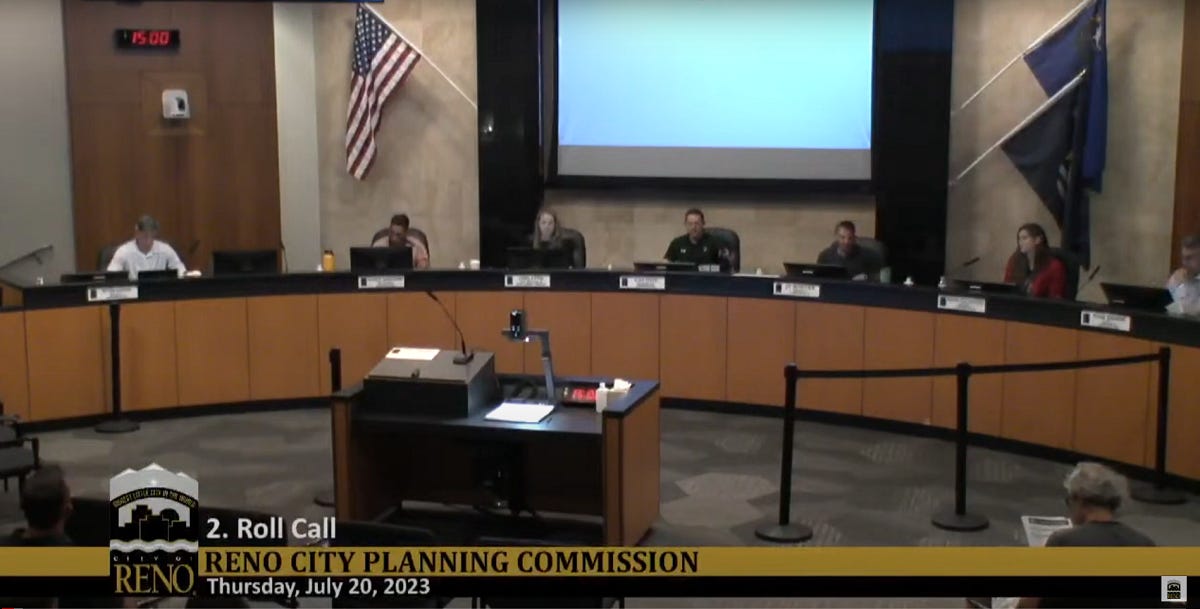The City of Reno has been engaging in some important work over the past month including finalizing the ward redistricting process. I’ll have more to say about that and its implications at a future date. But in the meantime, we have a special guest today in the Briefing room. As I’ve mentioned in the past, my husband, Mark Johnson, served on the City of Reno’s Planning Commission, and a few weeks ago, he completed eight years of service on that body. 
The Planning Commission plays a central role in the development of our community, and I think it’s perhaps one of the least understood bodies in our city government. So now that his two terms have ended, I asked if he might be willing to share some insights about the experience, to help residents get a clearer sense of the commission’s role in development and how we can all participate in its deliberations. And I thought the best way to do that might be by interviewing him. So here we go!
First of all, Mark, I want to thank you for letting me interview you. Over the past eight years, you’ve obviously become an authority on what Reno’s Planning Commission is and does. So how would you describe the role of the Planning Commission?
The Planning Commission is arguably the most powerful unelected body in the City, with final approval authority over land use and development standards. Unless a project requires a change to a Master Plan designation, a decision by the Planning Commission is the final word (unless appealed to Council).
The City provides a short description of the commission:
“The Reno City Planning Commission advises the City Council on the long term physical development of the City including such issues as natural resources, economics, housing, population, land use and zoning. The Planning Commission reviews all major development projects proposed within the City and also provides a forum for public comment on issues dealing with development of our community.”
The second portion of that description is the most familiar part of what the commission does—hold public meetings to review major development projects. This is part of what is known as the “entitlement process” where development that is not expressly allowed in the code or due to its location, size, function, or type is submitted for review as an additional “entitlement” to the property.
I think that’s an important thing to understand, that the Planning Commission doesn’t review all development projects.
Correct. There are projects that are “allowed by right,” and there are projects that require entitlements that require discretionary review—either through a staff process or by Planning Commission and/or City Council. The term “allowed by right” is definitely a concept that requires some explanation. The Master Plan and development code were written to encourage development that meets the goals of the City. When something is “allowed by right,” that means the type of project (housing, warehouse, casino, etc.) and the location where it is proposed align with the stated goals. Unless some secondary code concern such as residential adjacency, hillside development, etc. is a part of the project, there is no public review as it is “allowed by right.” As a result, many projects can be constructed without any public review.
Not all projects that require entitlements go before the Planning Commission—just the “major” ones. Some categories of entitlements are publicly noticed but are reviewed and decided by City staff without being seen by the Planning Commission. The commission reviews the larger items such as tentative maps (for projects including more than four parcels), conditional use permits (such as a commercial development next to a residentially zoned property), “major” site plan review (for larger projects or impacts), or deviations that alter code requirements by more than 10%, as well as zoning and Master Plan changes.
So what role does the public play in all of this?
Because of the nature of the projects heard at Planning Commission, and the impact on adjacent properties, there is typically public comment provided. To accommodate, the meetings are held in Council Chambers in the evening at a time that is more convenient to most community members. Members of the public are actively encouraged by the City to attend Planning Commission meetings for projects occurring near them through direct mailings (the yellow postcard) and signs posted on the impacted site (those lovely yellow boards with the City logo at the top). Each project on the agenda is presented to the commission by the “applicant” with additional information provided by City staff. After the presentations, the commission calls for public comment prior to the start of commissioner questions and discussion.
The public comment portion is integral to the review process and often brings up items that may not have been addressed by the applicant or considered by the staff. While the bylaws of the commission and Robert’s Rules of Order prevent direct question and answer between the public and the commission, the topics raised frequently become the basis for the deliberations and approval/denial of the project.
Read the rest: https://thebarberbrief.substack.com/p/spotlight-the-reno-planning-commission
The Barber Brief is an independent e-newsletter and blog written by Dr. Alicia Barber on the Substack platform. It is reposted by This Is Reno with her permission.


